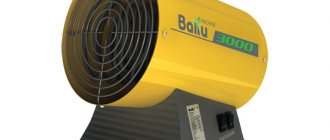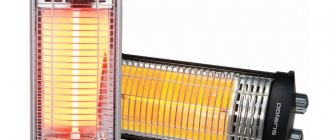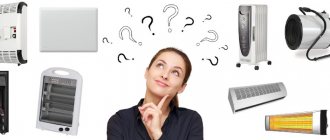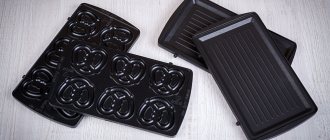You can heat the room in cold weather with any heater. However, the heating process will occur differently in each case. Therefore, many homeowners have to choose which heater is better, infrared or oil, and compare them with other types of convectors. It is possible to answer this question correctly only by studying the parameters, efficiency and other characteristics of each device.
Choosing which heater is better
Infrared
80%
Oil radiator
20%
Voted: 5
Operating principle of an infrared heater
The operating principle of infrared devices should be considered from the point of view of physical methods of transferring thermal energy in space. The main ones are:
- Convection. There is constant heat exchange in the air. Heated objects give off heat and heat the air, which, in turn, begins to rise upward. Heavier cold air currents take its place, and the whole process is repeated in the presence of a heat source.
- Radiant energy. All surfaces with a temperature above 60 degrees begin to intensely emit electromagnetic waves that have thermal energy. To obtain this effect, the waves must be in the range from 0.75 to 100 microns. This principle is used in the heating elements of IR heaters.
The heater itself is placed in a metal case coated with protective paint against corrosion. The internal part is filled with an aluminum reflector that acts as a heat emitter. It receives primary heat from heating elements.
The operating principle of an infrared heater is implemented in the following sequence:
- Current flows to the element and heats it.
- The element transfers its heat to the reflector - the heat-emitting plate.
- The heat reflected from the plate is emitted into space in the form of directed infrared rays.
- The rays hit surfaces within reach and heat them.
- Next, the principle of convection discussed above comes into play. Heat is transferred from surfaces and heats the surrounding air, providing uniform heating in a given area.
Convector: pros and cons
Heating a country house with convectors in the absence of central heating is a solution that has recently become more common. Such units are also used in ordinary houses with low heating, apartments, cafes, hotels and offices.
Operating principle of the electric convector:
- Cold air enters the device from below through natural circulation.
- Passing through the heating element, the air heats up and rises.
- Heated air masses give off heat to the body elements and exit from above through a special grille.
The advantages of an electric convector are:
- Mobility and possibility of permanent installation.
- Uniform air heating.
- Safety and ease of use.
- Fast heating.
The disadvantages include the following features:
- High price of the product.
- Dry the air.
Comparison of an infrared heater with an oil heater
Everything can be learned by comparison, including choosing the most suitable heater. First of all, you need to compare their parameters, capabilities and functionality in relation to specific operating conditions.
What heats better is an oil radiator or an infrared one?
Heaters with coolant oil heat quite well, but at the very beginning after switching on they warm up very slowly. The heating process lasts approximately 30 minutes, and during this time the room will be either cold or cool. Many devices are equipped with fans that accelerate air movement, reducing heating time.
The length of infrared waves is identical to the sun's rays, so a person perceives heat in this way. The rays spread unhindered and are not afraid of wind or drafts. Effective heat exchange allows you to feel the warmth in the shortest possible time. It should be remembered that not the entire room is heated, but only those areas where the rays are directed.
The maximum room temperature is reached after operating the IR heater for several hours. After turning off the device, the surfaces still continue to give off heat, but not for long. In this case, oil radiators cool down much more slowly.
Which heater is more economical?
If you compare the efficiency of both devices and decide which is better, then, of course, IR devices win. Their electricity consumption is approximately 10-30% less than that of oil heaters with the same power. Similar savings can be achieved by reflective plates installed behind the heating elements.
However, the associated operating costs for oil radiators are significantly lower. They do not require spare parts, maintenance or expensive repairs. IR devices require periodic replacement of lamps or bulbs that have expired.
Therefore, each room should be carefully considered and assessed based on the feasibility of installing this particular device in it. Optimizing the use of heaters will go a long way toward balancing overhead costs.
Size comparison
Infrared and oil heaters have approximately the same dimensions. There are many different designs, models and options, one way or another related to the principles of operation of the devices. A lot depends on the power, which directly affects the dimensions of the device.
- Oil heaters are placed on the floor or wall. There are no ceiling models, since it is irrational to use such devices at the top. There will simply be nowhere for the warm air to rise.
- Infrared devices can be installed anywhere. Depending on the size and weight, they have legs, vertical stands, ceiling, wall and corner mounts.
Innovative infrared convective heaters
In search of an answer to the question of whether to choose an oil heater or a convector, many people pay attention to devices such as infrared-convective heaters. They are an invention of recent years, combining the properties of an electric convector and an infrared installation:
- The heating element generates thermal energy.
- Heat is transferred to the environment through the body surface.
- Part of the warm air is removed through a special grille through natural circulation.
The units use two heating elements - convection and IR panel.
The advantages of ICO are:
- Multitasking.
- Long service life.
- Safety.
- Ergonomics.
- Quickly heats a room even with a large area.
The disadvantage is the ability to “eat” oxygen. In addition, this technique is very expensive.
Tips for choosing a heater for your home
In order to avoid unnecessary material waste when choosing an oil or infrared heater, you should adhere to certain rules. First of all, you need to consider the following factors:
- Place of installation of the device. It is recommended to determine in advance, since the type of heater and the efficiency of further heating directly depend on this. It should be taken into account that oil radiators are quite bulky, and falling is contraindicated for IR devices. In addition, they require certain installation methods. The most optimal models are wall-mounted. They cannot be touched by negligence, and they do not take up useful space in the room.
- Heater power for home. It is recommended to select this parameter according to a simple scheme: per 10 m2 of area, 1 kW of energy will be required for an oil radiator and 0.5 kW for an infrared device. Otherwise, the heater will not give the desired effect.
- Heater control. Mechanical and electronic systems are commonly used. The first option is cheaper, but it wears out quickly, has limited functionality, and has a high error in settings. Electronics, despite the high price, are much more efficient. Its precise operation makes using the heater more convenient and comfortable.
- Heating temperature. Oil-based appliances can become very hot during operation. Therefore, if you have small children, you should buy models where the surface of the radiator is protected by a frame that prevents direct contact with the hot surface. Among IR devices, there are micathermic devices that emit heat, but themselves remain cold.
Right choice
*
If you intend to buy an oil heater, you need to carefully choose the right model. Be sure to consider the power of the device. It should be sufficient to heat the room. The required power should depend on the size of the room and the presence of windows and doors in it.
Attention: The quality of room heating also depends on the number of sections.
The more there are, the better you can warm the room. But at the same time, a large number of sections will negatively affect the weight of the heater.
The oil heater must be equipped with a thermostat, which is necessary to regulate the temperature and operating mode. Some heater models are additionally equipped with a timer, fan, clothes dryer, and remote control.
In general, oil heaters have proven themselves to be the best over the years of use. They allow you to efficiently warm the room and maintain the desired temperature for a long time.
Operation and care of heaters
Any device will last much longer if you follow simple rules during operation:
- You cannot place things to dry on a radiator that is on. This can only be done after first disconnecting the device.
- When the infrared heater is turned on, it should not be located near flammable objects. The distance from any objects should not be less than 50 cm.
- Avoid touching the electrical cord to the hot surface of the heater.
- Keep the device clean and regularly wipe away dust. In this case, the device must be turned off in advance and allowed to cool.
- Floor-standing models can only be used in a vertical position.
Oil or convector?
Oil radiators have a sealed design. The principle of their operation is extremely simple: the heating element heats up mineral oil, which transfers its heat through a ribbed metal body. A special feature of the oil cooler is its slow warming up. The heating element needs time to warm up itself and only then heat the coolant.
In the convector the heating element has no “intermediary”. Heat is immediately transferred from it to the room after warming up. A small part of the energy goes to the metal panel, the main part is used to heat the air. It will require less electricity to generate heat than an oil cooler. But this indicator can be ignored, since it will have to work continuously. When a certain level of heating is reached, the oil one turns off and thereby compensates for energy consumption.
Conclusion:
- An oil type heater will cope much better with the task of warming up a room for a long time.
- If you need an immediate and short-term result, the convector wins.
Fan heater or infrared?
IR heaters have different designs, quickly and silently warm up the desired area of the room and the person. They do not create air flow movements. When choosing a device, you should choose models with an improved security system.
Inexpensive, mobile, often multifunctional fan heaters quickly distribute heat throughout the room. But they dry out the air and raise dust.
Conclusion:
- When quiet operation is important and discomfort is felt from air movement, it is better to purchase an IR heater.
- If noise does not bother you, you can opt for a fan heater.
Rating of the best convector heaters of 2021
Neoclima Fast 1500 w
The stylish and functional heater is equipped with three power levels - 850, 650 and 1500 W. Quickly and effectively creates in a room up to 20 square meters. m. comfortable microclimate. Stable feet are provided for floor installation. Using the handles on the sides, it can be moved safely and easily to the desired area.
A mechanical thermostat allows you to adjust the desired heating level. temperature. Safety in operation is ensured by an overheating protection system
Pros:
- economical energy consumption;
- frost protection function;
- stable design;
- affordable price.
Minuses:
- there is no temperature scale on the thermostat;
- There is no possibility of wall mounting.
Galaxy GL8227
The convector has high heat transfer and evenly fills a room of up to 17 square meters with heat. m. The thin, stylish body allows installation anywhere in the room. There is a stand with wheels and a wall mount. Equipped with a thermostat and simple mechanical controls. Durability in operation is ensured by an overheating protection system and an anti-freeze function. Settings are adjusted on the side panel of the case.
Pros:
- stylish design;
- power and temperature adjustment;
- anti-freeze function;
- wall and floor installation;
- good quality power cable.
Minuses:
- flimsy heating control knobs;
- some elements of the body are made sloppily.
Electrolux ECH/B-1000 E
The convector is assembled in a black housing and is designed to heat an area of up to 15 square meters. m. The maximum power consumption is 1000 W. It is possible to use the 500 W mode. Electronic control allows you to set the desired air temperature in the room. The device is equipped with parental control and anti-freeze functions. The convector housing is protected from mechanical impact from sharp and heavy objects and water splashes.
Pros:
- convenient electronic control;
- presence of a timer;
- shockproof panel coating;
- quickly heats the room;
- not afraid of humidity.
Minuses:
- display backlight is too bright;
- short cord.











